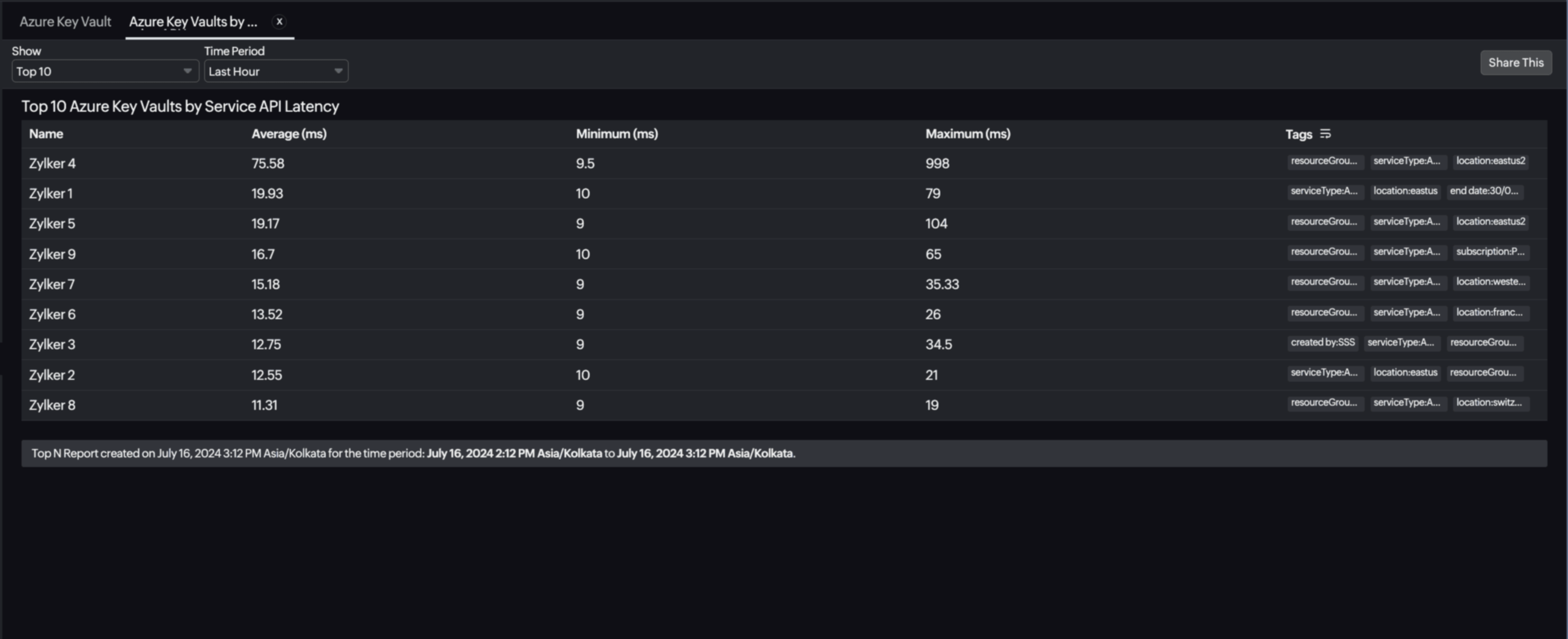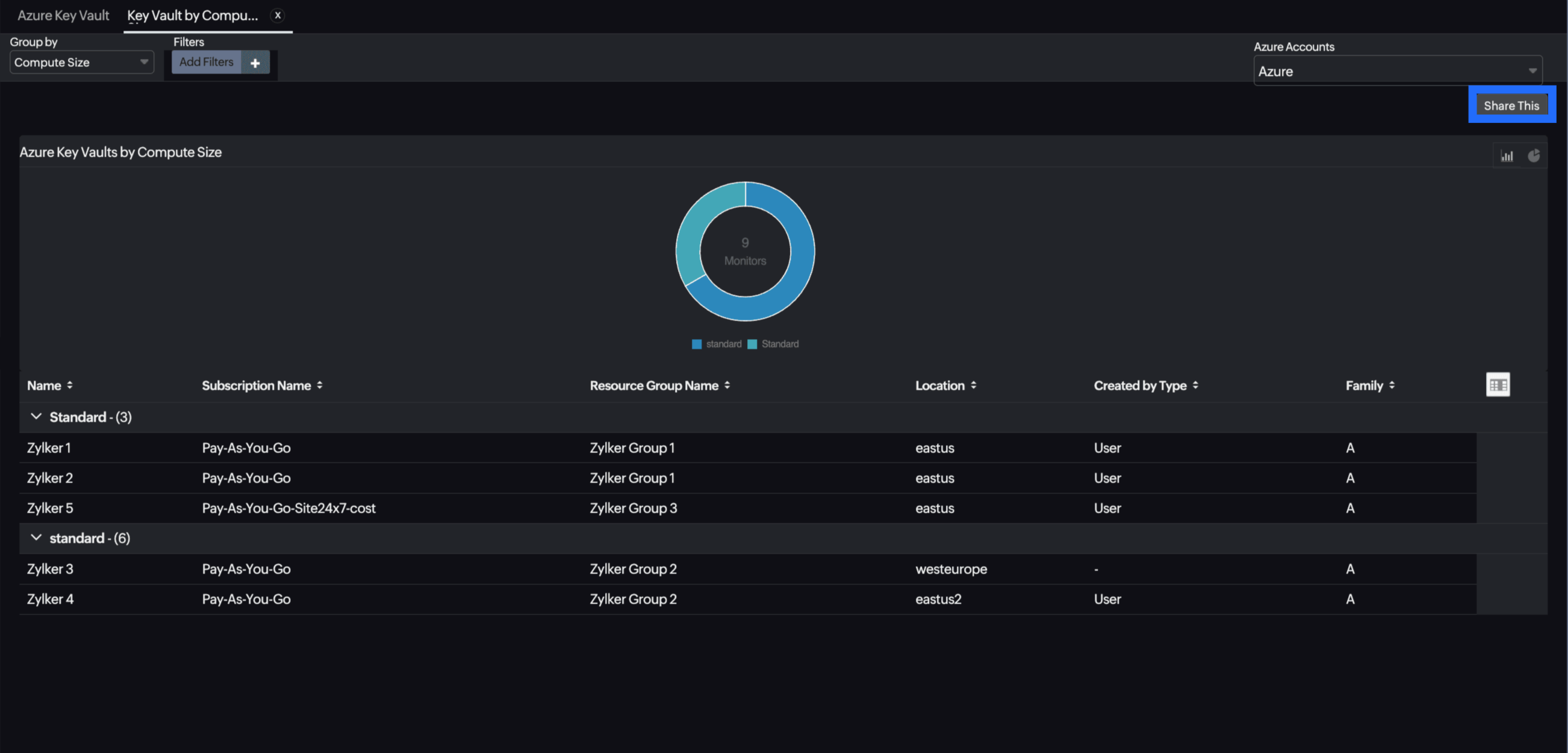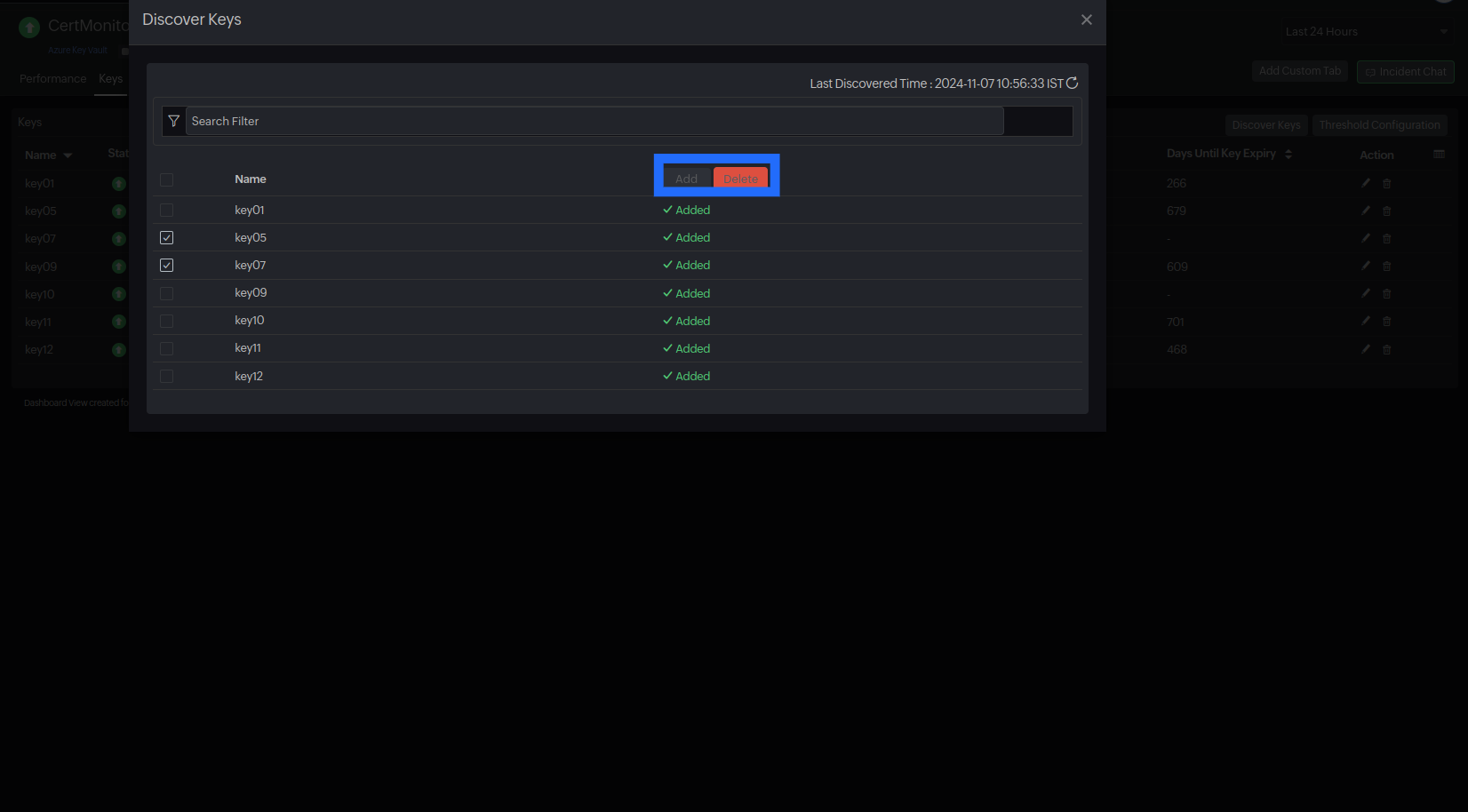Monitor Azure Key Vault
As you scale the usage of your Azure Key Vault service, monitoring becomes crucial due to the increasing number of requests. Site24x7 helps you track this growth, preventing latency issues and request throttling, which could impact your service's performance.
With Site24x7, you can ensure your Key Vault service remains responsive and efficient, even as demand rises, safeguarding the performance and reliability of your service.
Setup and configuration
Adding Key Vault while configuring a new Azure monitor
If you haven't configured an Azure monitor yet, or if you're setting one up for the first time, follow the steps below to add an Azure monitor along with Azure Key Vault:
- Log in to your Site24x7 account.
- Choose Cloud from the left navigation pane, and select Azure > Add Azure Monitor. You can also follow these steps to add an Azure monitor.
- During Azure monitor configuration, on the Add Azure Monitor page, select Azure Key Vault along with other required resource types from the Service/Resource Types drop-down. Check if you have configured the corresponding resource groups and tag filters in the Edit page.
Adding Azure Key Vault to an existing Azure monitor
If you already have an Azure monitor configured for the tenant, you can add Azure Key Vault by following these steps:
- Log in to your Site24x7 account.
- Navigate to Cloud > Azure and select the Azure monitor from the left pane for which you wish to add Azure Key Vault.
- On the Service View page, click the Enable Monitoring button for the Azure Key Vault service type. Check if you have configured the corresponding resource groups and tag filters in the Edit page.
It will take 15-30 minutes to discover new Azure resources. To immediately discover the selected configuration, click Discover Now in the top-right corner, and all the resources that match the filters configured on the Azure Edit page will be discovered even if the Auto-Discover New Resources option is disabled.
Now you can view the discovered resources from the Service View dashboard itself.
Polling frequency
Site24x7's Azure Key Vault monitor collects metric data every minute and the statuses from your applications every five minutes.
Required permissions
Ensure the Azure Key Vault has appropriate permissions assigned to the application used by Site24x7. Without the permission below, discovery will fail:
-
Key Vault Reader permission
Key monitoring
Site24x7 monitors all keys present in your Azure Key Vault to ensure their availability and timely usage tracking. This includes:
-
Status checks and health monitoring of stored keys.
-
Expiry date tracking to help you proactively rotate keys.
-
Alerts on unauthorized access attempts or permission issues.
Monitoring keys ensures that critical encryption assets are always available and secure.
Certificate monitoring
Monitor the life cycle of certificates stored in your Azure Key Vault with Site24x7. Key capabilities include:
-
Automatic detection of certificates and their associated metadata.
-
Expiry monitoring with alerts to avoid service disruptions.
-
Visibility into certificate usage and renewal needs.
This allows teams to prevent certificate-related outages and maintain compliance effortlessly.
Secret monitoring
Site24x7 continuously monitors secrets within your Key Vault to help manage application credentials, connection strings, and other sensitive data. This includes:
-
Discovery and status tracking of secrets.
-
Expiration alerts to ensure timely updates.
-
Notifications on access or availability issues.
Secrets monitoring helps maintain secure and uninterrupted access to critical configuration data.
Consolidated view
You can get a consolidated view of all the keys, secrets, or certificates across your Key Vaults by navigating to Cloud > Azure > Azure Key Vault and selecting the required component from the drop-down menu.

Auto-discovery of keys, certificates, and secrets
Site24x7 enables automatic discovery of Azure Key Vault components—keys, certificates, and secrets—to streamline monitoring and management.
Benefits
-
Avoid manual updates when new certificates or secrets are added.
-
Stay on top of expiration and availability issues.
-
Get a comprehensive view of Key Vault health and contents automatically.
How to enable automatic discovery
To enable automatic discovery:
-
Go to Cloud > Azure.
-
Select Azure Key Vault from the Azure drop-down, and click the required Azure Key Vault.
-
Click the hamburger icon
near the monitor name to navigate to the Edit Azure Key Vault monitor page.
-
Toggle Yes beside Auto Discover Key Vault Components.
-
Save your changes.
This enables periodic discovery and monitoring of all Key Vault components.
The discovery process runs once daily between 00:00 and 00:15, based on your account's configured timezone.
Supported metrics
The forecasted metrics are denoted as (FM).
| Metric | Description | Statistic | Unit |
|---|---|---|---|
| Overall Vault Availability | The average percentage of vault requests availability | Average | Percent |
| Overall Vault Saturation | The average percentage of the vault capacity that is used | Average | Percent |
| Total Service API Hits (FM) | The total number of service API hits | Count | Count |
| Overall Service API Latency | The overall latency of service API requests | Average | Milliseconds |
| Total Service API Results (FM) | The total number of service API results | Count | Count |
Azure Uptime monitoring
Site24x7’s Azure Uptime monitoring enables proactive tracking of your Azure resources’ availability and uptime, along with their configuration and inventory details. Note that uptime monitoring will disable performance metric data collection.
Threshold configuration
Associating a threshold profile can be done from the monitor's Edit page:
- Under Configuration Profiles > Threshold and Availability > select the corresponding threshold profile from the drop-down.
The changes made to this threshold profile will be applied to all the associated monitors. You can either add or edit a threshold profile by clicking the + or pencil icon, respectively.
Bulk Action
Bulk association of threshold profiles can be done from the Admin page (Admin > Inventory > Bulk Action > under Monitor Configuration, go to Modify Threshold Profile).
You can set threshold values for the metrics by selecting the Threshold and Availability option. You can also configure IT automation at the attribute level.
Default thresholds
Site24x7 alerts you based on a set of default thresholds. These default thresholds ensure that your service capacity is not overutilized, thus maintaining optimal storage and performance and reducing costs.
These are the default threshold categories:
- Resource Health
- On Change Configuration
- Metrics threshold
Resource Health:
- Alert if Resource Health is Unavailable
- Alert if Resource Health is Unknown
On Change Configuration:
- Alert if Deployment Status is Changed
- Alert if Disk Encryption Status is Changed
- Alert if Template Deployment Status is Changed
- Alert if RBAC Authorization is Changed
- Alert if Public Network Access is Changed
Metrics threshold:
- Overall Service API Latency
- Overall Vault Saturation
- Overall Vault Availability
Additional attributes threshold
- Alert if the Key has Expired
- Alert if the Key has been Deleted
- Alert if the Key has been Disabled
- Alert if the Certificate has Expired
- Alert if the Certificate has been Deleted
- Alert if the Certificate has been Disabled
- Alert if the Secret has Expired
- Alert if the Secret has been Deleted
- Alert if the Secret has been Disabled
IT automation
Site24x7 offers a set of exclusive IT automation tools to auto-resolve performance degradation issues. These tools react to events proactively rather than waiting for manual intervention.
How to configure IT automation for a monitor
Configuration Rules
With Site24x7's Configuration Rules, you can set parameters like Threshold Profile, Notification Profile, Tags, and Monitor Group for multiple monitors. These rules can be configured and run for the existing or new monitors (during addition) matching the given criteria.
How to add a configuration rule
Reports
Gain in-depth data about the various parameters of your monitored resources and accentuate your service performance using our insightful reports.
To view reports for Azure Key Vault:
- Navigate to the Reports section in the left navigation pane.
- Select Azure Key Vault from the menu on the left.

- You can find the Availability Summary Report and Performance Report for one selected monitor. Or you can get the Inventory Report, Key Vault by Compute Size, Summary Report, Availability Summary Report, Health Trend Report, and Performance Report for all the monitors. Additionally, you can view the Top N and Bottom N Report.
Key Vault by Compute Size
Site24x7's Azure Key Vault monitoring also provides a Key Vault by Compute Size report that will enable you to gain deep insights into your resources.
Top N and Bottom N reports
- Azure Key Vaults by Service API Latency

To schedule a report:
- Schedule the Inventory Report by navigating to Reports > Azure Key Vault > Inventory Report.
- Click the Share This button at the top-right corner.
- In the Schedule Report pop-up, choose the monitor, assign the desired frequency—daily, weekly, monthly, or quarterly—and send regular reports on your inventory details to the groups that you desire.

You can also view the reports from the Performance tab of the Azure Key Vault monitor.
- Navigate to the Performance tab of the Azure Key Vault monitor.
- Get the Availability Summary Report of the monitor by clicking Availability.
- Find the Performance Report of the monitor by clicking any chart title.
Site24x7's Key Vault monitoring interface
Get an overview of the availability and usage status of your Key Vault environment.
Performance
The Performance tab helps you view the API hits and latency information, vault saturation details, and availability status.
Keys
The Keys tab gives you information about the keys specific to the resource, along with the created and updated time, the activation and expiry dates, and the days until expiration.
If you wish to add keys for monitoring or delete keys from monitoring, click Discover Keys at the top right corner. In the pop-up window, select the keys and then click Add or Delete.


If the key is not listed, click the refresh icon at the top right corner to trigger discovery.
Certificates
The Certificates tab provides you with the details regarding the certificates specific to the resource, along with the created and updated time, the activation and expiry dates, and the days until expiration.
Secrets
The Secrets tab gives you information about the secrets specific to the resource, along with the created and updated time, the activation and expiry dates, and the days until expiration.
If you are unable to view the Keys, Certificates, and Secrets related attributes, ensure that you have sufficient permissions as specified in this document.
Configuration Details
The Configuration Details tab provides the configuration details of your Key Vault environment. Details on the compute site, vault creation, status of RBAC authorization, soft delete, disk encryption, deployment, and more are included on this tab.
Zia Forecast
By leveraging the AI-driven Zia framework, you can examine resource consumption measurements through the forecast chart located in the Zia Forecast tab. This chart predicts upcoming performance metrics based on a seven-day historical data analysis, providing insights into the expected metric usage for the next seven days.
Outages
The Outages tab provides the history of the Key Vault's statuses, including Down, Trouble, and Critical.
Inventory
The Inventory tab provides details on licensing, threshold and availability profiles, the set notification profiles, the set user alert group, and the monitor's created time and modified time.
Log Report
The Log Report tab lists all the logs collected during every data collection along with their statuses.
Related links
-
On this page
- Setup and configuration
- Polling frequency
- Required permissions
- Key monitoring
- Certificate monitoring
- Secret monitoring
- Auto-discovery of keys, certificates, and secrets
- Supported metrics
- Azure Uptime monitoring
- Threshold configuration
- IT Automation
- Configuration Rules
- Reports
- Site24x7's Key Vault monitoring interface
